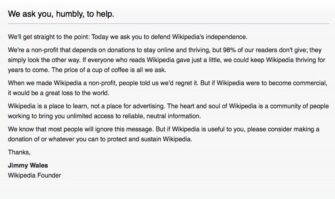Let’s Play A Game
Here’s a game for you, the professional fundraiser.
Below is Wikipedia’s solicitation. It has been floating around for a while now, and, as a behavioral scientist, I wonder why they haven’t changed it yet.
Can you spot the issues with this request? Tell us in the comments section what they are and what suggestions tied to evidence you have for improvement.
[To see what we would do differently (Hint: it’s 4 things), look out for Monday’s post.)

Looking forward to reading your ideas!
Kiki
6 responses to “Let’s Play A Game”
Ask A Behavioral Scientist
Behavioral Science Q & A
Whether “help” is more engaging or not really depends on the framing and context. The word help can sometimes weaken the perceived agency of the supporter, making their role feel secondary rather than central (your point). On the other hand, help can also signal collaboration rather than implying full ownership of the outcome, which might […]
Read Full Answer
Great question! Here’s how behavioral science can help unpack what might be happening: Pain of Paying: Even a small extra charge can make giving feel more transactional than emotional, potentially reducing generosity. Fairness Concerns: Some donors might perceive donor cover as a surcharge rather than a contribution to the cause. If they feel the charity […]
Read Full Answer
The choice between “Your gift CAN…” and “Your gift WILL…” taps into the psychological framing of certainty vs. possibility. Currently, there is no academic research directly comparing these two framings in charitable appeals. However, I suspect no framing is universally better—the outcome likely depends on your target audience and the campaign’s goal. Here are some thoughts: Certainty Framing – […]
Read Full Answer
Integrating an individual giving appeal with other communications from a charity can have both positive and negative effects, and the outcome largely depends on how it’s executed. Advantages of Integration Brand Consistency: Maintaining a consistent appearance and messaging across all communications can reinforce the org’s brand identity and strengthen brand recognition and trust among your […]
Read Full Answer
I’m not aware of any in-market tests specifically comparing recurring vs. gift frequency language. I suspect the answer might not be the same with all gift frequencies, nor with all people. It sounds like a great opportunity for you to test and find out what works for your audience. Based on the literature, here’s a couple […]
Read Full Answer
Based on what we know from existing data, those renewal notices can actually be pretty effective in getting people to donate. They tap into our psychology – creating a sense of urgency, reminding us of past support, and using personalization to make the message hit home. They’re playing on our natural tendencies to feel obligated […]
Read Full Answer


Interestingly, Wikipedia’s fundraising messages have been tested tens of thousands of times, and the “most people don’t give” line is one product of that huge amount of testing. It definitely, definitely works for them.
I did a blog about this last year: https://medium.com/@chriskfundraising/why-doesnt-social-proof-work-for-wikipedia-fundraising-65d55a047911
Hi Chris, thanks for sharing their report – good to know Wikipedia tested the negative social proof message out. That answers part of the research question I had in mind – the other half will be revealed on Monday. Let’s continue this conversation then!
Indeed – look forward to seeing your other thoughts!
I would suggest that most of it be in the “I” the founder, vs “we” Wikipedia voice to strengthen the I/you direct connection with reader. Everything else looks good–it matches who they are, their tone. I have given to them, and hardly give to anyone 🙂
Just looked up their financial statement for 2019 which they post on their website. $111 Million posted in donations and contributions, and a pretty fine balance sheet.
Thanks Gayle – the fact they raise good money on this request doesn’t mean they couldn’t raise even more if it was adapted. That’s why Wikipedia keeps testing messages too. We just wanted to identify key behavioural principles that could be tested to see if they could increase giving further. But you’re right, my word choice (“issues”) was probably not the right one.